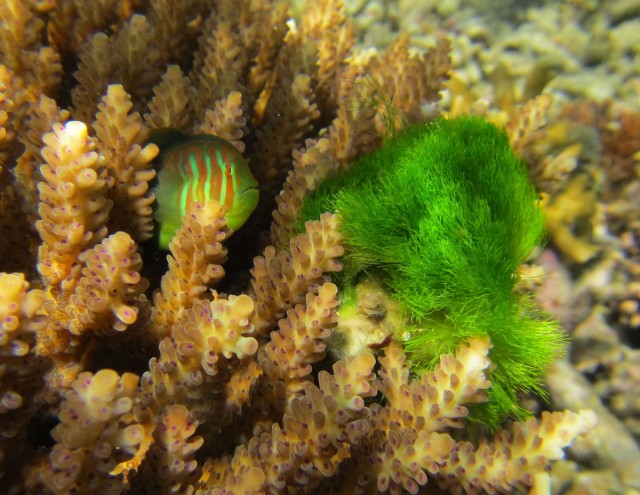
There are lots of organisms that don't have a brain, but can still communicate. Bacteria coordinate their growth, plants signal distress and lure insects in with scents and coloring. Now, researchers have listened in on some of the communication going on in a coral reef, and found that the organisms are saying the equivalent of things like "help me!" and "die!" Finding Nemo, this isn't.
At the root of these communications is a competition between corals and an algae called Chlorodesmis fastigiata. In the wild, the algae can start growing on reefs, where it is able to send a simple message to nearby coral: die. Various studies have indicated that the algae can carry coral disease and create an oxygen-depleted environment that's harmful to corals. Within three days of researchers placing the algae on a coral, the coral's photosynthetic activity dropped by about 80 percent. With the corals gone, the algae can then occupy the reef.
But, as researchers found, corals can fight back. Simply placing an extract of the seaweed near the coral caused it to emit its own message: come help me! The recipients of this message? Fish called gobies. Pairs of these fish generally occupy a nest at the base of a coral growth. But, in the authors experiments, simply exposing a bit of coral to an extract of the toxic seaweed was enough to attract most of the gobies in the area in as little as 15 minutes.
Once there, the fish got to work. Over three days, the abundance of the seaweed dropped by about 30 percent. And, more significantly, the corals recovered the majority of the metabolic activity that they had lost when the algae first appeared.
The authors tested this with two species of goby. In one case, the fish simply cleared off the algae without eating it. But a second one happily chowed down on the intruder, based on an examination of its stomach contents. The authors noted a difference between these species: the one that ate the algae also had a predator defense that involved producing a mucus that was toxic to other fish.
So, the authors tested whether eating the algae was necessary for the production of the toxic stew. It wasn't, but they did find that consuming algae increased the potency of the toxins, which was able to disorient predators twice as fast if the fish that produced it had been chewing on seaweed.
In all, the picture this research paints is a mix of symbiosis and chemical warfare. The primary combatant is the algae, which tries to off the nearby coral. That sets off a chain of mutually beneficial interactions, as the coral attracts gobies, which can find a home there and help clear off the intruder. At least one of these goby species benefits even further by increasing its own chemical warfare assault at the expense of the algae.
But not everyone is arming for battle. The researchers also tested a damselfish that lives in corals, and found that it ignores all the chemical signaling going on.
The authors point out that corals are declining rapidly around the globe, being stressed by things like pollution, rising temperatures, and ocean acidification. Efforts to preserve them may be able to benefit from a greater understanding of the full ecosystem in which corals live.
Science, 2012. DOI: 10.1126/science.1225748 (About DOIs).
reader comments
15